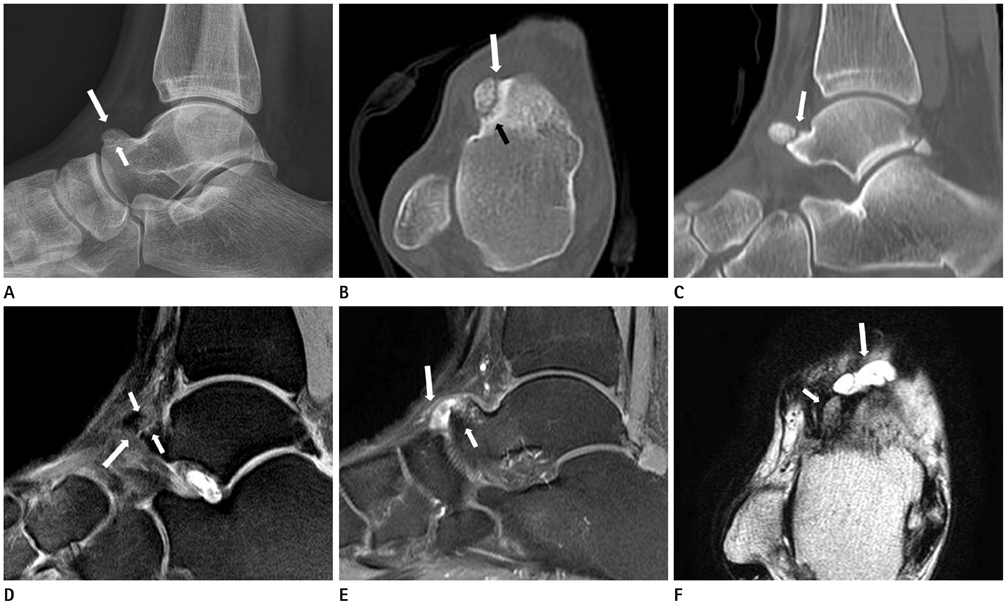J Korean Soc Radiol.
2013 Oct;69(4):317-320. 10.3348/jksr.2013.69.4.317.
Imaging Findings of CT and MRI of Os Supratalare: A Case Report
- Affiliations
-
- 1Department of Radiology, Haeundae Paik Hospital, Inje University College of Medicine, Busan, Korea. bluesingirl@paik.ac.kr
- KMID: 2041954
- DOI: http://doi.org/10.3348/jksr.2013.69.4.317
Abstract
- The os supratalare is quite a rare accessory ossicle of the ankle and the foot. We present imaging findings of a symptomatic os supratalare in a 21-year-old woman with a painful bump of the dorsal aspect on her hind foot. CT and MRI are helpful to distinguish this accessory ossicle from a fracture or an osteochondroma. Knowledge of imaging findings and clinical significances of os supratalare will be helpful for accurate diagnosis and appropriate management.
Figure
Reference
-
1. Coughlin MJ. Sesamoids and accessory bones of the foot. In : Coughlin MJ, Mann RA, Saltzman CL, editors. Surgery of the Foot and Ankle. Philadelphia: Mosby;2007. p. 531–610.2. Coskun N, Yuksel M, Cevener M, Arican RY, Ozdemir H, Bircan O, et al. Incidence of accessory ossicles and sesamoid bones in the feet: a radiographic study of the Turkish subjects. Surg Radiol Anat. 2009; 31:19–24.3. Cilli F, Akçaoğlu M. [The incidence of accessory bones of the foot and their clinical significance]. Acta Orthop Traumatol Turc. 2005; 39:243–246.4. Tsuruta T, Shiokawa Y, Kato A, Matsumoto T, Yamazoe Y, Oike T, et al. [Radiological study of the accessory skeletal elements in the foot and ankle (author's transl)]. Nihon Seikeigeka Gakkai Zasshi. 1981; 55:357–370.5. Mellado JM, Ramos A, Salvadó E, Camins A, Danús M, Saurí A. Accessory ossicles and sesamoid bones of the ankle and foot: imaging findings, clinical significance and differential diagnosis. Eur Radiol. 2003; 13:Suppl 6. L164–L177.6. Mellado JM, Salvadó E, Camins A, Ramos A, Saurí A. Painful os sustentaculi: imaging findings of another symptomatic skeletal variant. Skeletal Radiol. 2002; 31:53–56.7. Karasick D, Schweitzer ME. The os trigonum syndrome: imaging features. AJR Am J Roentgenol. 1996; 166:125–129.8. Miller TT, Staron RB, Feldman F, Parisien M, Glucksman WJ, Gandolfo LH. The symptomatic accessory tarsal navicular bone: assessment with MR imaging. Radiology. 1995; 195:849–853.9. Osuji OU, McAdams TR. Dorsoulnar wrist ganglion associated with os ulnostyloideum: a case report. Am J Orthop (Belle Mead NJ). 2007; 36:E94–E96.10. Romanowski CA, Barrington NA. The accessory navicular--an important cause of medial foot pain. Clin Radiol. 1992; 46:261–264.
- Full Text Links
- Actions
-
Cited
- CITED
-
- Close
- Share
- Similar articles
-
- Imaging Findings of a Solitary Fibrous Tumor in Pancreas: A Case Report
- CT and MRI Findings of Low-Flow Mediastinal Vascular Malformation: A Case Report
- A Comparative Study of Survivor Outcomes between Preoperative Evaluation Using CT Alone and Combined CT and MRI in Patients with Pancreatic Ductal Adenocarcinoma
- US, CT and MR Imaging Findings of Leiomyoma of Urinary Bladder: Case Report
- Wallerian degeneration of brain: MRI and CT findings


